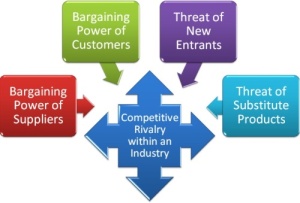Jan 7, 2013
The End of Strategy? Our Faculty Discusses

Oh the irony! First introduced in 1979, Harvard Business School professor Michael Porter’s Five Forces analysis of competitiveness has continued to make its mark. The forces—which include the bargaining power of suppliers, the bargaining power of customers, the threat of new entrants, the threat of substitute products, and the competitive rivalry within the industry—have been widely used to understand the factors that affect profits in an industry. Yet in November of 2012, the Monitor Group, a strategy consulting firm co-founded by Porter, filed for bankruptcy.This led Forbes contributor Steve Denning to ask, “Why didn’t the highly paid consultants of Monitor use Porter’s famous five-force analysis to save themselves?” In a widely read 3000-word article, Denning uses Monitor’s demise to lambast the Five Forces. In the process, he raises serious questions about the nature and future of strategy consulting. Denning attributes Monitor’s problem to a “conceptual error” on Porter’s part: “In the theoretical landscape that Porter invented,” he writes, “all strategy worthy of the name involves avoiding competition and seeking out above-average profits protected by structural barriers. Strategy is all about figuring out how to secure excess profits without having to make a better product or deliver a better service.” And this, he argues, is neither a boon for society nor, in the long-term, for a firm. Denning’s is a harsh indictment. Yet the Five Forces are still widely taught at top business schools, including here at Kellogg. I have invited a number of Kellogg faculty members who teach strategy to consider Denning’s arguments. What follows are the thoughtful responses of professors Craig Garthwaite, Thomas Hubbard, David Dranove, David Besanko, Meghan Busse, Mike Mazzeo, and Justin Lenzo in the form of a written dialogue.Craig Garthwaite
Denning’s is a harsh indictment. Yet the Five Forces are still widely taught at top business schools, including here at Kellogg. I have invited a number of Kellogg faculty members who teach strategy to consider Denning’s arguments. What follows are the thoughtful responses of professors Craig Garthwaite, Thomas Hubbard, David Dranove, David Besanko, Meghan Busse, Mike Mazzeo, and Justin Lenzo in the form of a written dialogue.Craig Garthwaite
 |
| Craig Garthwaite, Assistant Professor of Management & Strategy |
I must say that, in his attack on Michael Porter, Steve Denning constructs a fairly lengthy and pessimistic caricature of both the profession of management consulting and the academic field of the economics of strategy. After reading the article, one couldn’t help but think that strategy academics and consultants were just modern versions of historical snake-oil salesmen. Denning appears to believe that modern-day strategy is simply the search for industries whose basic characteristics lead to higher profits—an outcome he labels, or more accurately mislabels, a “sustainable competitive advantage.” He concludes that there are no (or very few) situations where these characteristics exist and therefore strategy practitioners are charlatans and frauds. While this straw man argument creates a compelling screed against Porter and his now defunct Monitor Group, it reflects an understanding of the current state of the economics of strategy that is far below that of even my worst first-year MBA student.The reality is that analyzing an industry’s basic characteristics, often through a framework such as Michael Porter’s Five Forces, is only a starting point for firm strategy. As we teach at Kellogg, once you understand these basic economic characteristics, you can move on to considering firm-specific assets and activities that generate above-average economic profits over time. This is a far more conventional, and frankly useful, definition of a sustainable competitive advantage.These above-average profits come not simply from high barriers to entry or favorable government regulations, but rather from a firm’s ability to effectively create and, importantly, capture value. Firms must capture value through prices determined in competition with other firms. However, at no point does this limit our analysis to a zero-sum contest for profits between firms in an industry. Innovative firms, such as those cited in Denning’s article, are often those who more effectively create value, differentiate their products, and sustain high profits.Thomas Hubbard
 |
| Thomas Hubbard, Elinor and H. Wendell Hobbs Professor of Management |
Hammers are really useful tools. It is hard, if not impossible, to build a house without one. But trying to build a house using only hammers won’t work. Denning’s main complaint is that strategists should not build houses using only hammers, and he accuses Monitor of trying to do so.Denning’s piece contains lots of narrow statements with which I agree. The broad point that strategists who focus only on industry analysis and/or “value capture” elements of a firm’s strategy are unlikely to provide useful guidance is a good one. The pervasiveness of the Five Forces framework often leads students, as well as some practitioners, to attempt to apply it irrespective of the question at hand. (“Why is the sky blue?” “It has few substitutes and few rivals, but it also has declining barriers to entry and little bargaining power versus its suppliers or customers.”) To a boy with a hammer, the world is a nail. This leads to all sorts of bad analysis and shortsighted/incomplete strategic prescriptions.The piece falls apart when it condemns Porter’s work on this basis. The fact that a hammer isn’t all that one needs, and that hammers are sometimes used inappropriately, does not mean that hammers are not useful. The framework is a very useful way of organizing one’s analysis of the question of whether and why a representative firm in one industry is more or less profitable than one in another industry. This is often an important question, and having a framework around which to structure the analysis generally improves the analysis.I agree with Craig: where managers go wrong is in treating this part of the analysis as an ending point rather than a starting point. It is unfortunate they make this mistake as often as they do. One thing that we all try to do when teaching these concepts to students at Kellogg, or when helping practitioners with the problems that they face, is to not only impart the concepts themselves but illustrate how they should and should not be applied.I also found other elements of Denning’s critique very strange. He writes that according to Porter, “[s]trategy is all about figuring out how to secure excess profits without having to make a better product or deliver a better service.” This makes me wonder whether he read Porter’s follow up book, “Competitive Advantage,” which is essentially about how firms can secure profits through better products and/or lower costs. This is an example of one of many very strange statements along these lines.And so I share Denning’s concerns about indiscriminate, narrow applications of the Five Forces framework—perhaps at Monitor and certainly elsewhere—and agree with him that it has sometimes overshadowed other, more useful concepts. But the conclusion that he draws is silly.David Dranove
 |
| David Dranove, Walter J. McNerney Professor of Health Industry Management and Professor of Management & Strategy |
In addition to Craig's and Tom’s excellent points, let me add my perspective from 25 years of teaching the Five Forces. Students often expect something from the Five Forces that just isn’t there. A good Five Forces analysis is not prescriptive; one does not walk away from the exercise with a strategic plan. So what is the point? One cannot develop or evaluate plans in a vacuum; one needs a solid empirical basis for analysis. But how does the strategist sift through the mountains of available information? The value of the Five Forces is that it uses economic theory to identify the most useful data. Doing strategy in the absence of theory can sometimes seem to be impossibly chaotic. Porter (and the economic theories he applies) brought method to the madness.Economic theory has significantly evolved since Porter’s original work, so much so that the Five Forces we teach today bears only a partial resemblance to the Five Forces in Porter’s classic HBR article. As economic theory evolves, so too does our understanding of what we need to know to craft and evaluate strategy: when we assess internal rivalry to evaluate pricing strategies, we worry about our rival’s reputations and multimarket contacts; when we assess buyer power to evaluate vertical integration strategies, we consider asset specificity and worry about opportunities for vertical foreclosure. By providing a framework that is systematic and adaptable, Michael Porter gave strategists something of enduring value.In his misguided critique of Porter’s Five Forces, Denning joins a long list of non-academics who try to criticize economic approaches to strategy but do nothing more than tear down straw men of their own creation.David Besanko
 |
| David Besanko, Alvin J. Huss Professor of Management & Strategy |
Not yet commented upon is that Monitor’s failure almost certainly had nothing to do with an over-application of Porter’s Five Forces or any other framework found in Porter’s writings. In terms of its approach to client work, Monitor was not terribly different from the other major firms with whom it competed, such as McKinsey, BCG, or Bain. Consulting teams in these firms never start a strategy engagement by saying, “Let’s do a Five Forces analysis.” Do consulting teams assess a client’s industry conditions and competitive environment? Yes, of course. But they don’t do so using simplistic cookie cutter approaches. The approach is typically nuanced and deploys multiple analytical tools (of which an analysis of the structural conditions of the client’s markets might be one). To say this is not to deprecate the value of Porter’s framework; it is merely to say that it is but one lens that strategists have at their disposal for doing the careful situational analysis that is needed for formation and evaluation of strategic options.All in all, Denning’s sophomoric article sheds no light on why Monitor failed, and it provides a grossly distorted picture of the state of modern strategic thinking. To paraphrase a line from the movie Billy Madison, you risk becoming dumber for having read it.Meghan Busse
 |
| Meghan Busse, Associate Professor of Management & Strategy |
I don’t have much to add to the excellent comments already made by my colleagues. Craig describes very well how we teach both industry analysis and sustainable competitive advantage (concepts that are not at all the same thing) in the core strategy course at Kellogg, and his description reflects my view as well.I tell students in class that Five Force analysis is like the checklists that pilots use when they fly planes. The checklist isn’t what makes you a pilot, but it does keep you from making a stupid mistake because you missed something at the beginning. Similarly, the Five Forces is a checklist that makes sure you have thought about the most important elements that define the competitive and economic context in which the firm operates. But it is at this point that the heavy lifting begins: now having understood the context, the strategist must figure out what set of activities the firm should engage in in order to create a sustainable competitive advantage.Despite Denning’s skepticism, I do think that there are firms that create a sustainable competitive advantage. By this, I don’t mean permanent, eternal, or inevitable profits, and I don’t mean (as Denning seems to understand the term) attractive industry characteristics. Instead, I mean the advantage obtained by firms who have chosen a set of activities that are well-suited to the economic context in which they operate, that are hard to imitate, that are mutually reinforcing, and which the firm has shown foresight in choosing. These firms do indeed tend to earn profits that are higher than those of their competitors, and profits that are durable rather than temporary or transitory. It is the superior profitability earned by firms who choose such a configuration of activities that I would term “sustainable competitive advantage.” Attractive industry characteristics are just a starting point.David BesankoJust a quick reaction to Meghan’s excellent post.I agree that we can find examples of firms that can create sustainable competitive advantages. But I wonder whether a charitable interpretation of Denning is that he is not necessarily arguing against this broad point, but rather is suggesting that it is generally difficult for firms (or business units within firms) to achieve sustainable competitive advantage by exploiting favorable competitive forces in Porter’s framework. He seems to be saying that even if you are clever enough, or lucky enough, to have situated yourself in an industry with high entry barriers, sooner or later Clayton Christensen—like disruptive innovation will kick in, and you’ll be toast.But even my charitable interpretation of Denning is problematic. It is not difficult to find examples of companies or business units that for years earn returns in excess of their costs of capital because they enjoy what Richard Rumelt calls positional advantages, competitive advantages that are rooted in the structural characteristics of industries, such as the confluence of economies of scale and market size that create room for just one or two big producers. We don’t often hear about these cases because many are in boring industrial backwaters that don’t get written about in Forbes. One of my favorite examples along these lines is U.S. Smokeless Tobacco Company, the dominant producer of smokeless tobacco products (like Skoal snuff), which, between 1982 and 2004, consistently earned positive economic profits and never earned a return on invested capital less than 24 percent! (I don’t have data before 1982 or after 2005, and in 2008, U.S. Smokeless Tobacco was purchased by Altria, but it is not unreasonable to conjecture that U.S. Smokeless Tobacco's streak of positive economic profitability extended over an even longer horizon.) Over this period, U.S. Smokeless Tobacco did little, if any, of the continuous customer-centric innovation that Denning considers the sine qua non of corporate success. As Meghan notes, no competitive advantage is eternal, but achieving returns above cost of capital in excess for over 20 years is the sign of a pretty darn durable advantage, even if management’s most significant contribution to the advantage was to merely tend the position and not kill the golden goose. Continuous innovation may be one route to sustainable advantage, but it is not the only route, and one of the advantages of competitive analysis based on economics (analysis that, as David Dranove suggests, was rooted in Porter’s work) is that we have frameworks for identifying and assessing the power of these various approaches to competitive advantage.Mike Mazzeo
 |
| Michael Mazzeo, Associate Professor of Management & Strategy |
I agree with my colleagues’ main critique of Denning’s article: the notion that Porter’s framework for Industry Analysis is a strategy panacea is a straw man, trivial to rebut. No one who teaches Porter’s framework believes this and Porter never claimed it to be so. In fact, as Tom pointed out, in “Competitive Advantage,” Porter focuses on the intellectual foundations of how firms create value. As Craig and Meghan characterized, we teach our MBA students strategy by emphasizing value creation in tandem with value capture. Porter’s influence has come from tying these ideas to underlying economic theory and effectively communicating them to generations of students and managers.On the topic of value creation, Porter’s contribution lies in his relentless insistence that firms acknowledge and incorporate the competition into strategic decision-making. Even if customers like the firm’s product, they have to like it better than what competing firms offer. Even if a process reduces a firm’s costs, it needs to be a process that competitors cannot replicate. Innovators who don’t ask themselves the question, “Why can’t another firm do this as well as we can?” will fail to profit from their initiatives, no matter how much value they create for consumers.Allow me to close with one more retort to Denning’s initial thesis that the demise of Monitor is evidence of the uselessness of the Five Forces framework. One might argue that Monitor’s failure demonstrates just the opposite. Because Porter’s work on industry analysis is so persuasive, so easy to communicate and rings so true, it has become ingrained in managers’ thinking. When teaching executive students, I often remark that one benefit of learning strategy well is that you won’t need consultants to guide you or to fix your mistakes. It follows that firms need consultants’ help on industry analysis less because Porter’s framework is so ubiquitous and universally understood. So, let’s instead toast the end of Monitor as the culmination of a job well done.Justin Lenzo
 |
| Justin Lenzo, Assistant Professor of Management & Strategy |
My colleagues identify the major weaknesses in Mr. Denning's rant against business strategy and the Five Forces framework. At the risk of sounding uncharitable, I cannot help but wonder whether Mr. Denning made the effort to really understand the ideas he condemns. Nevertheless, a couple of legitimate and important questions about strategy and its frameworks arise over the course of his article.First, as several of my colleagues have discussed above, there is no "one tool" that should be thought to provide a universal answer to questions of strategy. In fact, as important as the Five Forces are to understanding industry context, our core business strategy course in the Kellogg MBA program focuses on the topic for roughly one week out of ten. In other words, there are nine other weeks in which we focus on other tools and ideas (of course, connections are frequently made back to the Five Forces). The Five Forces has a well-defined purpose in strategy analysis: it provides a disciplined approach to identifying the threats to profitability of firms in a particular industry. It is not, in itself, about "selecting a business strategy" or "building sustainable competitive advantage" or "defeating the competition." Again, it is about identifying the threats to profitability for firms in a particular industry. To identify such threats is a crucial part of strategic analysis and planning, but only a part.Second, the article raises a broader question of whether good strategy focuses on "coping with competition" or focuses instead on "adding value for customers and ultimately society" through experimentation and innovation. The straw man here is that there exists a trade-off between the two. Truly sustainable competitive advantage necessitates a complementary mix of both. Firms that experiment and innovate—organizationally, as well as in the products and services they provide—are better positioned to continue to thrive in the face of context disruptions (such as disruptive technological change) that dramatically change the industry's structure. But experimentation and innovation require investable resources. Where do these resources come from? A firm that is isolated from price competition is likely better able to accumulate them.Furthermore, and more critically, what happens when the experimentation and innovation are successful? In the absence of barriers to entry and imitation, competitors will rush in to capture a share of the profits. Mr. Denning suggests, "Unlike competition in sports, every company can choose to invent its own game." Perhaps every company could invent its own game, but surely many would choose instead to pursue the low-hanging fruit of imitating successful strategies in industries with low entry barriers. Such imitation inhibits the innovative firm from recouping its investment, decreasing its incentive to innovate in the first place. Apple surely is, as Mr. Denning identifies, a continually innovating firm. However, Apple also relies on patent protection, trade secrets, brand reputation, easier access to financial capital, supplier capacity constraints, and other "structural barriers" to ensure that it captures value created by the risky investments it makes. Likewise, Mr. Denning's other model firms necessarily employ "competition coping" alongside their innovation efforts. Come to think of it, the Five Forces is an especially helpful framework in understanding the non-obvious aspects of these firms' strategies.